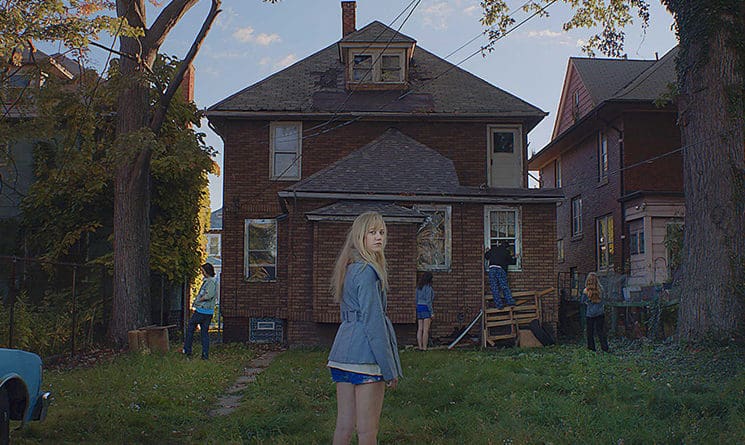The new horror film “It Follows” was inspired partly by one of writer/director David Robert Mitchell’s recurring dreams. In the dreams, Mitchell has said in interviews, he’s followed — or, more accurately, stalked — by a menacing figure. It moves slowly, gradually gaining ground on him. And it changes appearance. Sometimes, it looks like a friend or family member; other times, it’s a stranger. Whatever its shape, the figure is always there, just a few steps behind.
“It Follows” effortlessly captures that nightmarish dread. It’s a movie ruled by dream logic — the familiar and safe become dangerous and the surreal and unfathomable make sense at a gut level. There are rules and you know them instinctually, but you also know they can change at any time. The landscape and the characters are at once symbolic and also exactly what they seem. And, as the dream ends, there is no resolution or explanation, just a lingering feeling that the normal order of things is askew and may never be shifted back in place.
In other words, “It Follows” is unlike most modern horror films. Mitchell lets the characters and the atmosphere create the tension. There are no gimmicks, no convoluted origin stories for the monster, and, compared to other big-budget R- and PG-13-rated blockbusters, there’s little in the way of violence and gore. Because of all that, it’s delightfully scary, avoiding the usual jump scares (though it has a few of those) and aiming for a deep-seated dread that lingers after the credits end.
Our heroine is Jay Height (Maika Monroe), a 20-ish girl living in the Detroit suburbs. She goes out on a couple of dates with Hugh (Jake Weary) and they hit it off. The relationship gets physical, and after they have sex, Hugh reveals the truth. He’s being followed by a supernatural force, an unstoppable thing that can take on any form and that only he can see. If it touches him, it will kill him. He can outrun it, but it will eventually catch up. The only way to keep it away is to have sex with someone and pass on the curse.
Jay goes on the run. Her friends, Paul (Keir Gilchrist), a nerdy childhood friend who’s not so secretly in love with her; Yara (Olivia Luccardi); Greg (Daniel Zovatto), and her sister Kelly (Lili Sepe) rally around her. They camp out at her house, track down Hugh in search of information, and drive to a remote lake house, all in an effort to keep Jay safe and put some miles between her and the thing following her.
Nothing works, of course. The follower is implacable, invulnerable, and inevitable. It’s death, and in case that metaphor was lost on us, Mitchell litters the film with stanzas from Emily Dickinson and snippets from Dostoyevsky.
Mitchell seems to have internalized the language of John Carpenter, David Cronenberg, and other horror directors.
On the surface, “It Follows” seems like a blunt parable about STDs. It’s more than that, though. Unlike “Friday the 13th” and other ’80s horror films, which cemented the genre’s “sex equals death” trope, “It Follows” is, in a way, realistic in its attitudes about sex. Sometimes it’s positive and sometimes it’s not. It can happen for very good reasons and also for bad reasons. It’s the end result of a complex series of physical, emotional, and mental responses and, once it happens, often ends up creating more complications — some good, some bad. “It Follows” is just as much about navigating those decisions and complications — particularly when you’re young and facing them alone for the first time. It’s no accident that Jay’s mom is absent, and, like most horror flicks, there are no adults in the neighborhood.
Filmed on location in Detroit, “It Follows” roams through broken-down neighborhoods and faded suburbs. The characters hang out on porches festooned with battered plastic lawn chairs and watch old movies on analog televisions. Everything is old and tattered, the colors washed out, as if the city’s story ended some time ago and the characters are trapped in a never-ending epilogue. Bad decisions — made yesterday or decades before, either by the characters themselves or some unknown stranger — haunt every scene. As Jay and Paul, Monroe and Gilchrist are particularly great at infusing their characters with longing and regret. They reminisce and lapse into nostalgia, wishing the rules of childhood still applied to them while knowing that death itself is pacing deliberately toward them.
There are echoes of John Carpenter, David Cronenberg, and other horror directors in “It Follows,” but they’re not so much knowing winks as they are evidence that Mitchell seems to have internalized the language of those filmmakers. The moments of suspense and fear are genuine — Mitchell avoids gimmicks and cheap scares and goes straight for almost unbearable tension broken by moments of surrealism. In one scene, Jay and her friends hide from the follower in Jay’s bedroom, the door locked. Yara knocks on the door, demanding to be let in. Paul opens the door — it is, in fact, just Yara. A moment passes. And suddenly, the follower is there, now seemingly seven feet tall, hunched over in the narrow hallway, shambling aimlessly forward, as if it had been there all along and we could see it only now.
Our dreams, and our nightmares, are always with us, bundled up with our hopes and choices and regrets. Mitchell seems to remind us that we ignore them at our peril —they may be chasing us, but they are also driving us forward into the rest of our lives.

